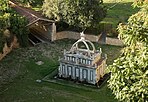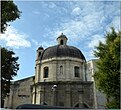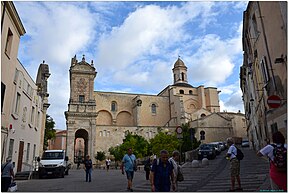Sassari
This articleneeds additional citations forverification.(March 2024) |
Sassari
| |
|---|---|
| Comune di Sassari | |
From top left:view of the city; Piazza D'Italia; Rosello fountain; Church of Saint Mary of Bethlehem; Piazza Castello; and Cattedrale di San Nicola | |
| Coordinates:40°43′30″N8°33′31″E/ 40.72500°N 8.55861°E | |
| Country | Italy |
| Region | Sardinia |
| Province | Sassari(SS) |
| Frazioni |
|
| Government | |
| • Mayor | Giuseppe Mascia |
| Area | |
| • Total | 546.08 km2(210.84 sq mi) |
| Elevation | 225 m (738 ft) |
| Population (31 December 2015)[2] | |
| • Total | 127,567 |
| • Density | 230/km2(610/sq mi) |
| Demonym | Sassaresi or Turritani |
| Time zone | UTC+1(CET) |
| • Summer (DST) | UTC+2(CEST) |
| Postal code | 07100 |
| Dialing code | 079 |
| Patron saint | Saint Nicholas |
| Saint day | 6 December |
| Website | Official website |
Sassari(US:/ˈsɑːsəri,ˈsɑːsɑːri/SAH-sər-ee,SAH-sar-ee,[3][4]Italian:[ˈsassari];Sassarese:Sàssari[ˈsasːari];Sardinian:Tàtari[ˈtataɾi]) is an Italian city and the second-largest ofSardiniain terms of population with 127,525[5]inhabitants, and aFunctional Urban Areaof about 260,000 inhabitants.[6]One of the oldest cities on the island, it contains a considerable collection ofart.
Since its origins at the turn of the 12th century, Sassari has been ruled by theGiudicato of Torres,thePisans,as an independent republic in alliance withGenoa,by theAragoneseand theSpanish,all of whom have contributed to Sassari's historical and artistic heritage. Sassari is a city rich in art,cultureandhistory,and is well known for itspalazzi,theFountain of the Rosello,and its elegantneoclassical architecture,such as Piazza d'Italia (Italy Square) and the Teatro Civico (Civic Theatre).[7]
As Sardinia's second most populated city, it has a considerable amount of cultural,touristic,commercialandpoliticalimportance in the island.[8]The city's economy mainly relies on tourism andservices,however also partially onresearch,construction,pharmaceuticalsand thepetroleumindustry.[8]
Geography[edit]
Sassari is located in north-western Sardinia, at 225 metres (738 ft)above sea level.The area rises up on a widekarsticplateau that slopes gently down towards the Gulf ofAsinaraand theNurraplain. The city is surrounded by agreen beltof thousands of hectares ofoliveplantations,which from the 19th century have partly replaced the mixed woodlands ofoakand other Mediterranean trees as well as themaquis shrubland.The thinly populated Nurra Plain, located to the west, occupies the main part of the region of Sassari, while theurban agglomeration,with a population of about 275,000 inhabitants, is located to the south east. The abundance of water, with about 400 springs andartesian wells,has made for much development ofhorticultureover the centuries.
Climate[edit]
| Climate data for Sassari,Sardinia | |||||||||||||
|---|---|---|---|---|---|---|---|---|---|---|---|---|---|
| Month | Jan | Feb | Mar | Apr | May | Jun | Jul | Aug | Sep | Oct | Nov | Dec | Year |
| Mean daily maximum °C (°F) | 12.2 (54.0) |
12.5 (54.5) |
14.0 (57.2) |
16.3 (61.3) |
20.1 (68.2) |
24.0 (75.2) |
27.7 (81.9) |
27.8 (82.0) |
24.8 (76.6) |
20.7 (69.3) |
16.2 (61.2) |
13.1 (55.6) |
19.1 (66.4) |
| Mean daily minimum °C (°F) | 6.0 (42.8) |
6.1 (43.0) |
7.0 (44.6) |
8.8 (47.8) |
11.9 (53.4) |
15.4 (59.7) |
18.5 (65.3) |
18.9 (66.0) |
16.6 (61.9) |
13.5 (56.3) |
9.8 (49.6) |
7.0 (44.6) |
11.6 (52.9) |
| Averageprecipitationmm (inches) | 75 (3.0) |
76 (3.0) |
68 (2.7) |
65 (2.6) |
42 (1.7) |
20 (0.8) |
0 (0) |
17 (0.7) |
54 (2.1) |
98 (3.9) |
96 (3.8) |
85 (3.3) |
696 (27.6) |
| Average precipitation days | 7 | 7 | 7 | 6 | 4 | 2 | 0 | 1 | 4 | 6 | 8 | 8 | 60 |
| Mean monthlysunshine hours | 127 | 152 | 186 | 223 | 270 | 310 | 350 | 316 | 257 | 202 | 143 | 115 | 2,651 |
| Source: globopix[9] | |||||||||||||
History[edit]
This sectionneeds additional citations forverification.(March 2024) |
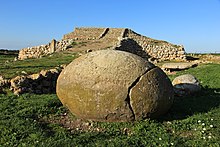
Prehistory and ancient history[edit]
Although Sassari was founded in theearly Middle Ages,the surrounding area has been inhabited since theNeolithicage, and throughoutancient history,by theNuragicsand theRomans.
Many archaeological sites and ancient ruins are located inside or around the town: the prehistoricstep pyramidofMonte d'Accoddi,a large number of Nuraghes andDomus de Janas(Fairy Houses), the ruins of a Roman aqueduct, the ruins of a Roman villa discovered under San Nicholas Cathedral, and a portion of the ancient road that connected the Latin city ofTurris LibisoniswithCaralis.In the locality ofFiume Santois also found a fossil site where anOreopithecus bambolii,a prehistoric anthropomorphic primate, was discovered, dated at 8.5 million years.
Middle Ages[edit]

The origin of the city remains uncertain. Among the theses, according to folk tradition the first village was founded around the 9th–10th century AD by the inhabitants of the ancient Roman port ofTurris Libisonis(currentPorto Torres), who sought refuge in the mainland to escape theSaracenattacks from the sea.
It developed from the merger of a number of separate villages, such as San Pietro di Silki, San Giacomo di Taniga, and San Giovanni di Bosove. The oldest mention of the village is in an 1131 document in the archive of the Monastery of St. Peter in Silki where is cited a man namedJordi de Sassaro(George of Sassari), a serf from the nearby village of Bosove. Sassari was sacked by theGenoesein 1166.[10]Immigration continued until, in the early 13th century, it was the most populous city in theGiudicato of Torres,and its last capital. After the assassination ofMichele Zanche,the latter's last ruler in 1275, Sassari became subject to theRepublic of Pisawith a semi-independent status.

In 1284, the Pisans were defeated by theGenoesefleet at theBattle of Meloria,and the city was able to free itself: it became theRepublic of Sassari,the first and only early independent renaissance city-state of Sardinia, with statutes of its own, allied to Genoa; the Genoese were pleased to see it thus withdrawn from Pisan control. Its statutes of 1316 are remarkable for the leniency of the penalties imposed when compared with the penal laws of the Middle Ages.[10]
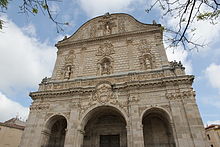
From 1323, the Republic of Sassari decided to side with the King of Aragon, in whose hands it remained for much of the following centuries, though the population revolted at least three times. The revolts ceased when KingAlfonso V of Aragonnominated the town as a Royal Burg, directly ruled by the King and free from feudal taxation, during a period in which it may have been the most populous city in Sardinia. Further attempts made byGenoato conquer the city failed. In 1391 it was conquered byBrancaleone DoriaandMarianus V of Arborea,of the independent SardinianGiudicato of Arborea,of which it became the last capital.[10]
However, in 1420, the city was sold along with the remaining territory for 100,000florinsto the Crown of Aragon, replaced by Spain after 1479 on the joining of the Aragonese and Castilian thrones. During the period of Aragonese and then Spanish domination the city was known asSàsserinCatalan languageandSaçerin oldSpanish.[citation needed]
Renaissance[edit]
The city alternated years of crisis, featuring economic exploitation, the decrease of themaritime trade,made unsafe by the daily raids ofSaracenpirates, political corruption of its rulers, the sacking of Sassari in 1527 by the French, and two plagues in 1528 and 1652, with periods of cultural and economic prosperity. TheJesuitsfounded the first Sardinianuniversityin Sassari in 1562. In the same year the first printing press was introduced and the ideals ofRenaissance humanismbecame more widely known. Several artists of theManneristandFlemishschools practiced their art in the city.
Modern history[edit]


After the end of the Spanish period following the European wars of the early 18th century, the brief period ofAustrianrule (1708–1717) was succeeded by domination by the Piedmontese, who then took over the title ofKingdom of Sardinia(1720–1861). In 1795 an anti-feudal uprising broke out in the town, led by the Emissary of theViceroyGiovanni Maria Angioy,a Sardinian civil servant, who later fought unsuccessfully against thehouse of Savoy.The city was occupied by troops at the time. The dynasty of the Piedmontese King of Sardinia went on to the monarchs of Italy. Sassari, along with the rest of Italy, became part of the newly createdKingdom of Italy.
At the end of the 18th century, theuniversitywas restored. In 1836, after six hundred years, themedieval wallswere partially demolished, allowing the town to expand. New urban plans were developed, on the model of the capital of the new regime (Turin), with geometric streets and squares.
Sassari became an important industrial center. In the 19th century it was the second most important town in what was to become the future Italy for the production ofleather,and in 1848 the Sassarese entrepreneurGiovanni Antonio Sannagained control of the mine atMontevecchio,becoming the third richest man in the new Kingdom of Italy. The first railway was opened in 1872.
In 1877 the oldAragonesecastle was demolished, and on the site the "Caserma La Marmora" was built, where the headquarters of "Brigata Sassari"is still located. Founded in 1915, it still consists mainly of Sardinian soldiers.
At the end of the 19th century new urban developments grew on Cappuccini Hill and to the south of the city, architecturally dominated byEclecticism,Art NouveauandArt Decostyles, which created a movement towards the hybrid experimentation of new local architectural styles, known as theSassarese Liberty.
During the Fascist dictatorship, the town had over fifty thousand inhabitants and new neighbourhoods were built, the most important of these being Monte Rosello and Porcellana, typical examples ofRationalist Architecture.On the other hand, the newspaperLa Nuova Sardegna,considered subversive, was closed down. During theSecond World Warthree Allied attempts to bomb the town failed: only the railway station was damaged, and there was only one casualty.
The 8th Stage of the2023 Giro Donnefinished at Salassa on 8 July.
| Year | Pop. | ±% |
|---|---|---|
| 1861 | 25,594 | — |
| 1871 | 32,315 | +26.3% |
| 1881 | 34,540 | +6.9% |
| 1901 | 37,746 | +9.3% |
| 1911 | 43,028 | +14.0% |
| 1921 | 43,792 | +1.8% |
| 1931 | 51,283 | +17.1% |
| 1936 | 54,926 | +7.1% |
| 1951 | 69,449 | +26.4% |
| 1961 | 89,107 | +28.3% |
| 1971 | 106,175 | +19.2% |
| 1981 | 118,631 | +11.7% |
| 1991 | 122,339 | +3.1% |
| 2001 | 120,729 | −1.3% |
| 2011 | 123,782 | +2.5% |
| 2021 | 122,159 | −1.3% |
| Source:ISTAT | ||
Culture[edit]
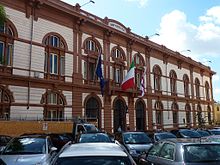
University[edit]
The University of Sassari is the oldest in Sardinia (founded by theJesuitsin 1562), and has a high reputation, especially in Jurisprudence, Veterinary Medicine, Medicine, and Agriculture. Its libraries contain a number of ancient documents, among them thecondaghes,Sardinia's first legal codes and the first documents written in theSardinian language(11th century) and the famousCarta de Logu(the constitution issued byMarianus IV of Arboreaand updated later by his daughter theGiudichessaEleanor of Arborea) in the 14th century.
The University of Sassari gained first place in 2009 in the ranking for the best “medium-sized” Italian university, awarded by the Censis Research Institute.
Language[edit]

Sassarese(SassaresuorTurritanu) is much closer toCorsicanandTuscan languagethan it is toSardinian,although this fact has caused some political controversy. It originated as alingua francabetween the firstSardinians,Corsicans,TuscansandLigurianpeople, during the period of themaritime republics.The originalTuscan structurewas influenced by theSardinian Logudoresespoken in the area, with a strong influence that can be felt in its phonetics and vocabulary, and byCatalanandSpanishin vocabulary.
Sassarese is spoken in Sassari and its immediate area by approximately 120,000 people out a total population of 175,000 inhabitants; it is also the language of the north-west of Sardinia, includingStintino,SorsoandPorto Torres;in the mid-northern areas of Sardinia, itsCastellanesidialects ofCastelsardo,TerguandSediniare more similar to theGallurese.
Main sights[edit]

- Archeological site ofMonte d'Accoddi:a unique prehistoric monument with astep pyramidconstruction
- ThePisanCity Walls that in the 13th century surrounded the city with 36 towers (at the moment only 6 remain), and theCatalan-AragoneseCastle namedCastello di Sassari,demolished in 1877, whose ruins, including some rooms, the basement, and part of a tower were rediscovered in 2008.
- The church of St. Peter in Silki, built in the 12th century but renovated in the 17th century. Here were found the medieval codes known asCondaghe di san Pietroin Silki.
- Corso Vittorio Emanueleis the main street of the medieval town, surrounded by interesting buildings of different ages, such as several examples of Catalan-gothic (as the so-calledHouse ofRe Enzo), the baroque church ofSant' Andrea,built by Corsican community, the neoclassicCivic TheatreandQuesada's palace.
- The Cathedral of St. Nicholas of Bari, built in the 13th century and enlarged in Catalan Gothic style from 1480; there is a monument to theDuca di Morianainside.[10]The façade, belonging to theBaroqueSpanish colonial restorations of 1650–1723, has a rectangular portico surmounted by three niches housing statues of saints. The bell tower is inRomanesquestyle.
- The church and monastery ofSanta Maria di Bètlem(13th–19th century). The original façade and parts of monastery are inLombard Romanesquestyle, some chapels inInternational Gothic,while the rest of the building, include the big dome, was rebuilt inBaroqueandNeoclassicstyle, by the Sardinian architect Antonio Cano in 1829–34.
- The Church of the Most Blessed Trinity contains a beautiful picture by an unknown artist of the Quattrocento.[10]
- TheCimitero comunale di Sassari(Sassari Cemetery) opened in 1837 adjacent to the Chiesa San Paolo al Cimitero just west of themain railway station
- Palazzo D'Usini,most important example of civilian architecture of the Renaissance period in Sardinia (now housing the main Public Library, therefore open to visits from the public).
- TheFountain of the Rosello,built in 1606 by Genoese craftsmen. It is made by two squared parts surmounted by two crossing arches supporting the statue of St. Gavino.
- University Palace (17th–20th century), originally a Jesuit school.
- The Ducal Palace (current Town Hall, 1775–1806), built for theDuke of the Asinarain the 18th century.
- Piazza d'Italia(19th century) is the main square in Sassari. It is surrounded by interesting buildings such as theNeo-Gothic"Palazzo Giordano" and theneoclassical"Palace of Sassari's Province", where the ancient royal apartments of theHouse of Savoywere once located.
- Teatro Verdi,opera house and theater for concerts and plays
Museums[edit]

- National Archaeological and Ethnographic "G.A. Sanna" Museum
- National Pinacotheca "Mus'A"
- Historical Museum of "Brigata Sassari"
- Museum of Science and Technology (it is constituted by many collections located in several university faculties:mineralogical,botanic,Entomological,zoological,anatomicalcollection "Luigi Rolando",physicsandagronomiccollection)
- Ethnographic Museum "Francesco Bande"
- Contemporary Art Museum "Masedu"
- Museum and Treasury of the Cathedral
- Museum of History of Sassari
- Museum of Sassari's Diocese
- Museum ofCandelieri
- Mario Sironiart collection
- Art gallery "Giuseppe Biasi"
- Pavilion of Sardinian handicraft EXPO "I.S.O.L.A."
Festivals and traditions[edit]

- TheFaradda di li candareri(Descent of the Candelieri) is a devotional procession, in which enormous wooden candles are carried by members of the cityguildsfrom the town centre to the church of Santa Maria of Betlem, in commemoration of the end of the plague in 1582, but it probably has older origins, from a cultural tradition fromPisathat as early as in the second half of the 13th century was practiced in some parts of Sardinia.
- TheCavalcata Sarda(the Sardinian Cavalcade), a main event in Sardinia. On the last Sunday of May thousands of people come from all over Sardinia to Sassari to parade through the city in their local folk costumes on foot and ride on hundreds of the best Sardinian horses.
- Sardinia Film Festivalwas founded in 2006. With 500 films,short subjects,animated cartoonsanddocumentariesin 2009, it has become the most prominentfilm festivalin Sardinia.
Sport & Infrastructures[edit]

Football[edit]
The city of Sassari hasU.S.D. Latte Dolce,theTorres Calcio Femminilethat won sevenSerie Atitles, eightCoppa Italia,seven Supercoppa Italiana and twoItaly Women's Cup.The main football team isS.E.F. Torres 1903who won the twoSerie C2in 1986-87 and 1999-00. The club is also famous for lanching players likeGianfranco Zola,Pietro Paolo Virdis,Antonello Cuccureddu,Comunardo Niccolai,Theofilos Karasavvidis,Walter Mazzarri.
Basketball[edit]
Sassari has the main basketball team thatDinamo Sassariin the2014–15wonItalian League,the club won also theItalian Cupin2014and2015and theItalian Supercupin 2014 and 2019. in2018–19the club won theFIBA Europe Cup.
Infrastructures[edit]
The city has the mainStadio Vanni Sannawhere it is held some concerts and where plays theTorres Calcio Femminile,S.E.F. Torres 1903andU.S.D. Latte Dolce.ThePalasport Roberta Serradimigniis the indor basketball arena where the basketball team ofDinamo Sassariplays and where it is held some concerts.
Government[edit]
Administrative subdivision[edit]
The Municipality of Sassari was subdivided into tencircoscrizioni(administrative districts), reduced to six since the elections of May 3, 2000, and four since the elections of May 31, 2010.
| Circoscrizioni | Population | Neighborhoods included |
|---|---|---|
| 1° Circoscrizione | 62,981 | Center, Carbonazzi, Porcellana, Rizzeddu, Monserrato, San Giuseppe, Cappuccini, Luna e Sole |
| 2° Circoscrizione | 37,814 | Latte Dolce, Monte Rosello, Santa Maria di Pisa |
| 3° Circoscrizione | 24,969 | Bancali, Caniga, La Landrigga, Li Punti, Ottava, Pian di Sorres, San Giovanni,Sant'Orsola |
| 4° Circoscrizione | 3,258 | Argentiera, Villassunta, Biancareddu, Campanedda, Canaglia, La Corte, La Pedraia, Palmadula, Tottubella, Rumanedda |
Economy[edit]
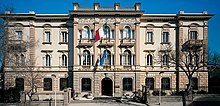
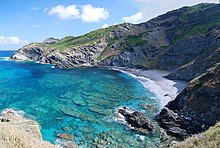
The economy of town is mainly focused on services and the advancedtertiary sector.It is the principal administrative centre of central and northern Sardinia. The main Sardinian banks (Banco di SardegnaandBanca di Sassari) have head office and presidency in the city.
Several research centers are located in town: the University ones, the Center of Regional Weather Service (Meteo Sar.), the Regional Agency for Environmental Protection (ARPA), the Zooprophylaxis Institute of Sardinia, and many labs of the National Research Center (CNR): the Institute of Biometeorology (IBIMET), the Institute of Biomolecular Chemistry (ICB), the Institute of Ecosystem Studies (ISE), the Institute of Sciences of Food Production (ISPA), and the Institute for Animal Production System in Mediterranean Environment (ISPAAM).
Manufacturing includes construction, pharmaceutical, food, typographic industry, and also, indirectly, petrochemical and the new greenchemicals located inPorto Torres.
Tourism is concentrated mainly along the coasts.Platamona,Porto Ferro,Porto PalmasandArgentieraare the principal seaside tourist spots of the municipality.
Transportation[edit]

The nearest airport,Fertilia International Airport,is 25 km (16 mi) from the city center, and the closest seaport is located atPorto Torres,16 km (10 mi) away.
Urban and suburbanpublic transportis operated by about 25 bus lines ofAzienda Trasporti Pubblici(ATP) and by alight rail transitofAzienda Regionale Sarda Trasporti(ARST). Two different railway companies connect the town to the rest of the island:Trenitalialinks Sassari toPorto Torres,Oristano,Cagliari,Olbia,Golfo Aranci,and the ARST reachesAlghero,Sorso,NulviandPalau.
Dual carriage motorways link Sassari toPorto Torres,Platamona,Cagliari(SS131),Olbia(SS199) and to Alghero (SS291). High-capacity traffic roads connect Sassari toTempio Pausania(SS672) andIttiri.
Sport[edit]
- A.S.D. Torres Calciofootball club, founded in 1903, playing inSerie C
- Torres Calcio Femminilewomen's football club, playing inSerie B,winners of seven national championships and eight national cups.
- Dinamo Basket Sassari,playing inLega Basket Serie A
- HC Tangram 1 Sassariwomen's team handball club, playing in Serie A1
People[edit]
Notable people born here include the former presidents of the ItalianRepublic,Antonio SegniandFrancesco Cossiga,andEnrico Berlinguer,secretary of theItalian Communist Party.
Sassari is also the birthplace ofDomenico Alberto Azuni,a jurist expert in commercial law.
Personalities[edit]
|
Notable historical personages
|
Contemporary personalities
|
International relations[edit]
Twin towns – sister cities[edit]
Sassari istwinnedwith:
- Gorizia,Italy, since 1983
- Timișoara,Romania, since 1990
- Gubbio,Italy, since 2002, between theFaraddaand theSaint Ubaldo Day
- Viterbo,Italy, since 2006, between theFaraddaand theMacchina di Santa Rosa
- Nola,Italy, since 2006, between theFaraddaand theFesta dei Gigli
- Palmi, Calabria,Italy since 2006, between theFaraddaand theVaria di Palmi
- Napoli,Italy since 2009, between theFaraddaand theDedication of Saint Mary Major
- Campobasso,Italy since 2009, between theFaraddaand theFestival dei Misteri
- Barcelona,Spain, since 2010 ( "artistic twinning")
See also[edit]
References[edit]
- ^"Superficie di Comuni Province e Regioni italiane al 9 ottobre 2011".Italian National Institute of Statistics.Retrieved16 March2019.
- ^"Statistiche demografiche ISTAT".Retrieved1 January2017.
- ^"Sassari".The American Heritage Dictionary of the English Language(5th ed.). HarperCollins.Retrieved5 May2019.
- ^"Sassari".Merriam-Webster Dictionary.Retrieved5 May2019.
- ^"Statistiche demografiche ISTAT".Retrieved1 January2017.
- ^"PIB et principaux composants - volumes".Archived fromthe originalon 2015-09-03.Retrieved2016-09-26.
- ^"Neoclassical – Artistic – Itineraries – Sardinia Tourism".Sardegnaturismo.it.Retrieved2011-09-16.
- ^ab"Sassari – History and culture".Sardegna.net.Retrieved2011-09-16.
- ^"Climate Statistics for Sassari, Sardinia".Retrieved23 November2012.
- ^abcde
 One or more of the preceding sentences incorporates text from a publication now in thepublic domain:Herbermann, Charles, ed. (1913). "Sassari".Catholic Encyclopedia.New York: Robert Appleton Company.
One or more of the preceding sentences incorporates text from a publication now in thepublic domain:Herbermann, Charles, ed. (1913). "Sassari".Catholic Encyclopedia.New York: Robert Appleton Company.
- ^"Antonio Cano 1775-1840",paradisola.it, 4 January 2021, accessed 6 January 2023 (in Italian)
- ^"With him is his cohort Michel Zanche ofLogodoro,and their tongues never tire with constant chatter about Sardinia."



